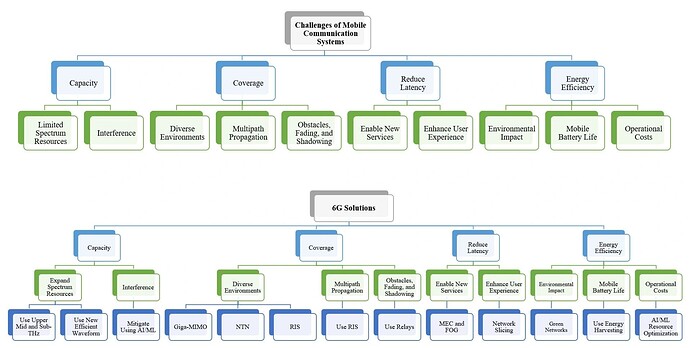Capacity Challenges
- Limited Spectrum Resources: Scarce and crowded spectrum restricts available bandwidth, hindering higher data rates.
- Interference: Signal interference from multiple sources degrades performance and reduces data speeds.
Coverage Challenges
- Diverse Environments: Urban, Rural, Indoor
- Obstacles, Fading, and Shadowing: Blocks the signal resulting in signal loss and reduced data rates.
- Multipath propagation cause both constructive and destructive interference, resulting in signal loss and reduced data rates.
Latency Challenges
- Reduce latency to enable new services (URLLC).
- Reduce latency to enhance user experience (AR/VR).
Energy Efficiency Challenges
- Environmental impact: Wireless devices and infrastructure consume large amounts of energy, contributing to carbon emissions and environmental degradation.
- Battery life: Mobile devices rely on batteries for power, and energy efficiency is critical to extending battery life and reducing charging frequency.
- Operational costs: Network operators need to reduce energy consumption to reduce operational costs and enhance sustainability.
6G Solutions
Capacity Solutions
- Limited Spectrum Resources: Use higher frequencies.
- Interference: Mitigated using AI/ML.
Coverage Solutions
- Diverse Environments: Use high order MIMO (Giga-MIMO at 7 GHz), use Satellite networks (NTN), use RIS (Reconfigurable Intelligent Surfaces).
- Obstacles, Fading, and Shadowing: Use relays and RIS.
- Multipath propagation: Use RIS.
Latency Solutions
- To enable new services: Use MEC and FOG.
- To enhance user experience: Use network slicing.
Energy Efficiency Solutions
- Environmental impact: Use green networks (rely more on renewable energy sources).
- Battery life: Use energy harvesting and power saving features.
- Operational costs: Use AI/ML to optimize resources according to usage needs.
LinkedIn: ![]()
